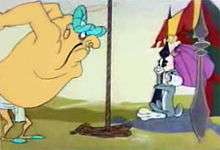Ali Baba Bunny
Ali Baba Bunny is a 1957 Warner Bros. Merrie Melodies short directed by Chuck Jones.[1] The short was released on February 9, 1957, and stars Bugs Bunny and Daffy Duck.[2]
| Ali Baba Bunny | |
|---|---|
 "Him go that-a-way"! | |
| Directed by | Chuck Jones |
| Produced by | Edward Selzer (uncredited) |
| Story by | Michael Maltese |
| Starring | Mel Blanc |
| Music by | Carl Stalling Milt Franklyn (musical direction, orchestra) |
| Animation by | Richard Thompson Ken Harris Abe Levitow Ben Washam Harry Love (special animation effects) |
| Layouts by | Maurice Noble |
| Backgrounds by | Philip DeGuard |
| Color process | Technicolor |
| Distributed by | Warner Bros. Pictures The Vitaphone Corporation |
Release date | February 9, 1957 (US) |
Running time | 6:55 |
| Language | English |
In 1994, it was voted #35 of the 50 Greatest Cartoons of all time by members of the animation field.[3]
The film was edited into the Looney Tunes greatest hits features The Bugs Bunny/Road Runner Movie in 1979 and Bugs Bunny's 3rd Movie: 1001 Rabbit Tales in 1982.[1]
Plot
In the Arabian Desert, a rich Sultan stores his treasure in a cave and leaves his guard Hassan to watch the cave. As the Sultan leaves, a burrowing trail crosses the desert towards the cave, bumps into Hassan's sword, and enters the cave. Enraged, Hassan attempts to kill the intruders but has trouble remembering the command to open the cave's door ("Open sesame"). While he tries random words beginning with 's', Bugs Bunny and his traveling companion Daffy Duck emerge from the burrow, believing they have arrived at Pismo Beach. Daffy's complaints about traveling underground and arriving at the wrong place end when he is mesmerized by the riches. Determined to keep it all for himself, he forces Bugs back into the burrow and eagerly indulges himself, jumping into the pile of treasure.
Hassan eventually says the correct command and marches in, mistaken by Daffy as a porter. After being attacked, Daffy flees in terror and attempts to bribe Bugs into saving his life. When Bugs ignores him, Daffy urges Hassan to attack Bugs instead, but Bugs disguises himself as a genie and fools Hassan into believing the treasure is his to claim for freeing him. Unwilling to give up the treasure, Daffy steals a large gem, and Hassan chases him. Daffy begs Bugs to save him, and Bugs reluctantly complies while berating Daffy for his greed. He sets up an Indian rope trick behind a rock and misleads Hassan up the rope. As Hassan disappears into the clouds, Bugs pulls the rope down, seemingly trapping him there permanently. Daffy runs back into the cave to claim the treasure.
After emptying the treasure, Daffy notices an oil lamp and polishes it. A grateful genie appears, but Daffy forces him back into the lamp, believing the genie is after the treasure. The enraged genie promises dire consequences for the duck's desecration as Bugs, unwilling and unable to save Daffy this time, hurriedly escapes via the burrow. Daffy shrugs off the genie's threats before the genie zaps him with bolts of magic. Later, in Pismo Beach, Bugs discovers Daffy's ultimate fate after finding a pearl in a clam: Daffy, shrunk to a few inches in height, claims the pearl as his own. The cartoon ends with Bugs making the clam close on the duck by saying "Oh, brudder. Close sesame!"
Cast
- Mel Blanc as Bugs Bunny, Daffy Duck, Hassan, Sultan and Genie
In popular culture
- During his SportsCenter tenure, Rich Eisen would occasionally use Hassan's catchphrase, "Hassan chop!", when a highlight showed a baseball player tossing his bat in disgust.[4]
See also
References
- Beck, Jerry; Friedwald, Will (1989). Looney Tunes and Merrie Melodies: A Complete Illustrated Guide to the Warner Bros. Cartoons. Henry Holt and Co. pp. 295, 372–373. ISBN 0-8050-0894-2.
- Lenburg, Jeff (1999). The Encyclopedia of Animated Cartoons. Checkmark Books. pp. 60–62. ISBN 0-8160-3831-7. Retrieved 6 June 2020.
- Beck, Jerry (1994). The 50 Greatest Cartoons: As Selected by 1,000 Animation Professionals. Turner Publishing. ISBN 187868549X.
- http://sportscenteraltar.com/phrases/usage.asp?ID=43